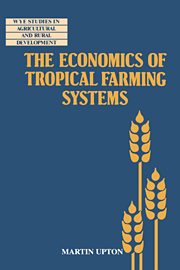9 - The economics of irrigated farming systems
Published online by Cambridge University Press: 05 June 2012
Summary
The benefits of irrigation
As we have seen in Table 2.1, about 17 per cent of the world's cropped land is under irrigation. Yet irrigated agriculture produces over 36 per cent of the total world output of crop products. It is forecast that by the year 2000 the share of total agricultural output produced under irrigation will increase further (Alexandratos 1988). These facts alone serve to emphasize the importance of irrigation as a means of increasing agricultural productivity. Table 2.1 also shows the wide intercontinental differences in the extent of irrigated agriculture. Whereas in Africa and Latin America irrigated farming systems are relatively unimportant, other than in a few countries, in Asia more than a third of all cropped land is irrigated. It can be inferred that most of Asia's food and other crop output is produced from irrigated farms.
Wet-rice cultivation is particularly important in humid areas of the Far East, such as China, Vietnam, Thailand, Indonesia, Malaysia and the Philippines, together with parts of Burma, Sri Lanka, and Eastern and Southern India. Other tropical irrigated crops, such as cotton, sugar cane, groundnuts, and vegetables are also grown in these and other more arid and semi-arid areas, where water supplies can be augmented. This is the case for major river-basin development schemes such as those of the Indus, the Nile and the Laguna area of Mexico.
- Type
- Chapter
- Information
- The Economics of Tropical Farming Systems , pp. 188 - 214Publisher: Cambridge University PressPrint publication year: 1996

